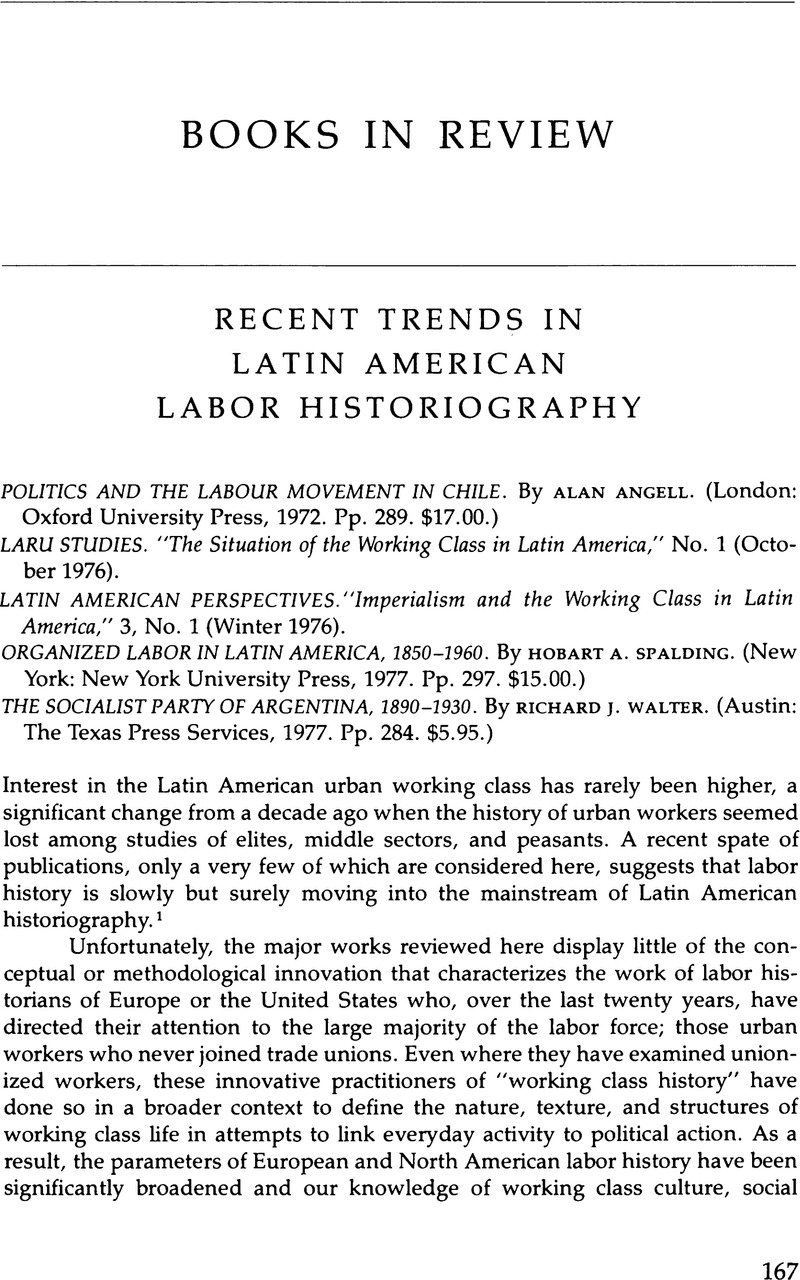Article contents
Recent Trends in Latin American Labor Historiography
Review products
Published online by Cambridge University Press: 24 October 2022
Abstract

- Type
- Books in Review
- Information
- Copyright
- Copyright © 1980 by Latin American Research Review
References
Notes
1. I would especially like to thank Paul Drake, Thomas Skidmore, and Jules Tygiel for their valuable criticisms and suggestions in the preparation of this article, and Stephen Brier, Edwin M. Epstein, Abraham F. Lowenthal, and Paulo Sergio Pinheiro for commenting on an earlier draft. I retain full responsibility for the final version.
2. Alaine Touraine and Daniel Pécaut, “Consciencia obrera y desarrollo económico en América Latina,” Revista Latinoamericana de Sociología (1966), p. 152. Leading proponents of the “working class history” perspective, and some of their relevant works, include: John Foster, Class Struggle and the Industrial Revolution (London, 1974); Herbert G. Gutman, Work, Culture and Society in Industrializing America (New York, 1977); Eric Hobsbawm, Labouring Men (London, 1964); David Montgomery, “Workers' Control of Machine Production in the Nineteenth Century,” Labor History 17, no. 4 (Fall 1976):485–509; E. P. Thompson, The Making of the English Working Class (New York, 1966); and Charles Tilly, Louise Tilly and Richard Tilly, The Rebellious Century, 1830–1930 (Cambridge, 1975). A provocative review of the assumptions underlying working class history is Daniel T. Rodgers, “Tradition, Modernity, and the American Industrial Worker: Reflections and Critique,” Journal of Interdisciplinary History 7, no. 4 (Spring 1977): 655–81. Elizabeth Jelin has critically reviewed the evolution of Latin American labor historiography in “Orientaciones e ideologías obreras en América Latina,” Estudios Sociales, no. 3 (oct. 1976).
3. Ramón E. Ruiz, Labor and the Ambivalent Revolutionaries (Baltimore, 1976) argues that the revolutionary potential of the Mexican working class had been blunted and dissipated long before Cárdenas assumed the presidency in 1934.
4. Liisa North and David Raby, “The Dynamic of Revolution and Counterrevolution: Mexico under Cárdenas, 1934–1940,” LARU Studies 2, no. 1 (Oct. 1977):26.
5. Ibid., p. 53.
6. On the role of the state see, among others, David Collier and Ruth Berins Collier, “Who Does What, To Whom, and How: Toward a Comparative Analysis of Latin American Corporatism,” in James M. Malloy (ed.) Authoritarianism and Corporatism in Latin America (Pittsburgh, 1977), chap. 15. Other articles in the same anthology are also illuminating. See especially Kenneth S. Mericle, “Corporatist Control of the Working Class: Authoritarian Brazil since 1964,” chap. 10. Also see Miguel Urrutia, The Development of the Colombian Labor Movement (New Haven, 1969).
7. Alistair Hennessy, “Latin America,” in Ghita Ionescu and Ernest Geller (eds.) Populism (New York, 1969), p. 30. More generally, see Fernando Henrique Cardoso and Enzo Faletto, Dependencia y desarrollo en América Latina (Buenos Aires, 1969).
8. Hennessy, “Latin America,” p. 53.
9. See Juan Eugenio Corradi, “The Politics of Silence,” Paper presented at the Annual Convention of the Modern Language Association, 1977 (revised version in press, Radical History Review). Corradi draws on Fernando Henrique Cardoso, “The Consumption of Dependency Theory in the United States,” LARR 12, no. 3 (1977):7–24; Cardoso and Faletto, Dependencia; and Alaine Touraine, Les sociétés dependentes (Paris, 1976).
10. Indeed, the final chapter of Organized Labor, “The Imperialist Threat,” is similar to the same author's “U.S. and Latin America: The Dynamics of Imperialist Control,” in the Latin American Perspectives issue under consideration. According to Spalding, “the results of U.S. labor's foreign policy have varied … but its greatest successes in Latin America have come in countries with authoritarian military regimes and its strongest supporters have been tied to conservative political parties and governments” (Organized Labor, p. 276), which suggests the need to study the dynamics of authoritarianism at least as much as it does the foreign policy of organized labor.
11. See Eugene F. Sofer, “Invisible Walls: Jewish Residential Patterns in Gran Buenos Aires, 1890–1947,” Occasional Paper #26, NYU Center for Latin American and Caribbean Studies, 1977, for a study of residential mobility and the dangers in assuming static neighborhoods.
12. Both Walter and Spalding uncritically cite Argentine strike data but the data offer more possibilities than they make use of. To take but one example, Walter notes that many more workers than union members participated in strikes. In such cases, a “solidarity index” similar to that used by Jon Amsden and Stephen Brier (“Coal Miners on Strike: The Transformation of Strike Demands and the Formation of a National Union,” Journal of Interdisciplinary History 7, no. 4 [Spring 1977]:583–616) would be useful. Also see Edward Shorter and Charles Tilly, “The Shape of Strikes in France, 1830–1960,” Comparative Studies in Society and History 8, no. 1 (Jan. 1971):60–85.
13. See Paul W. Drake, Socialism and Populism in Chile, 1932–1952 (Urbana, 1978).
- 6
- Cited by


